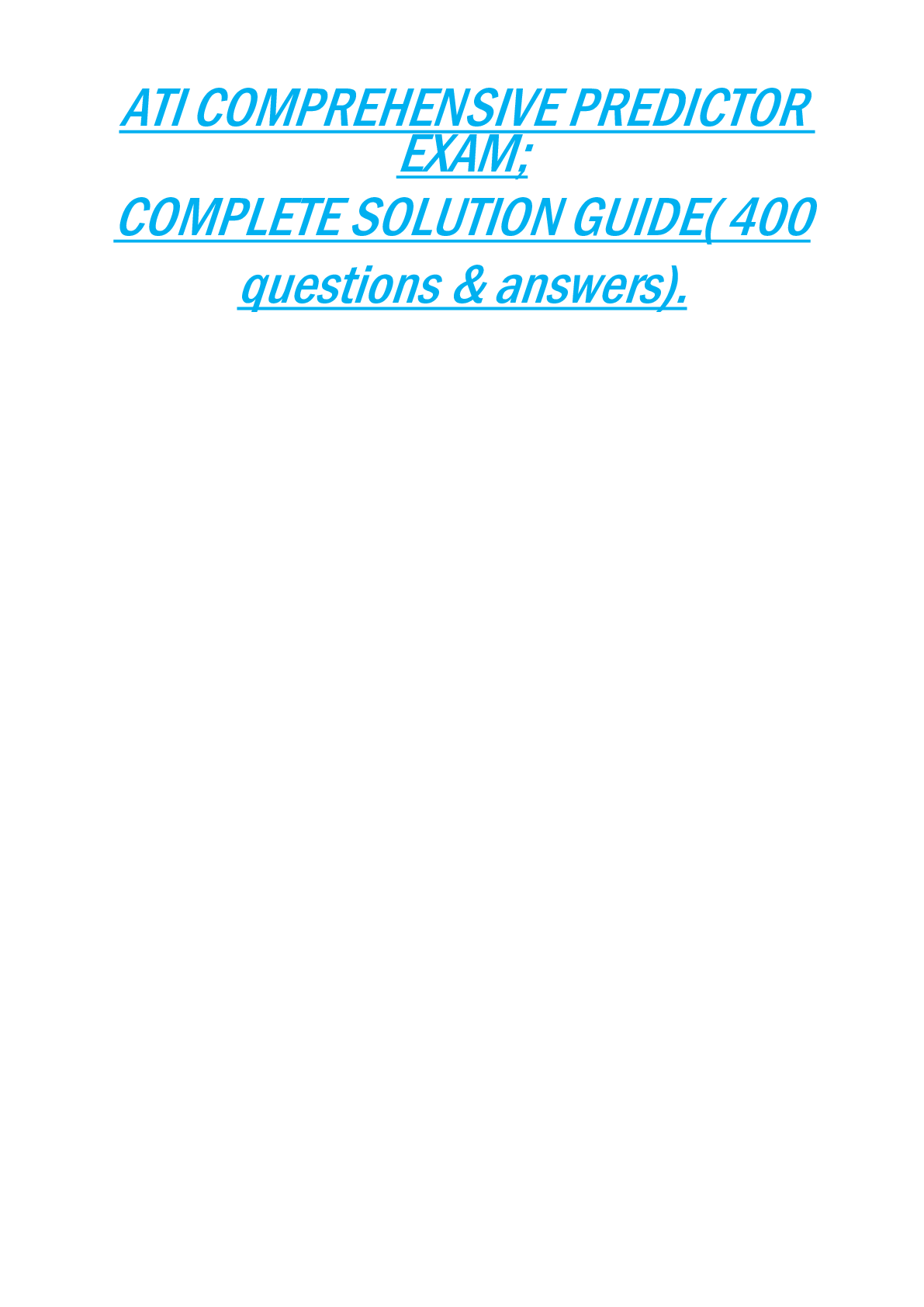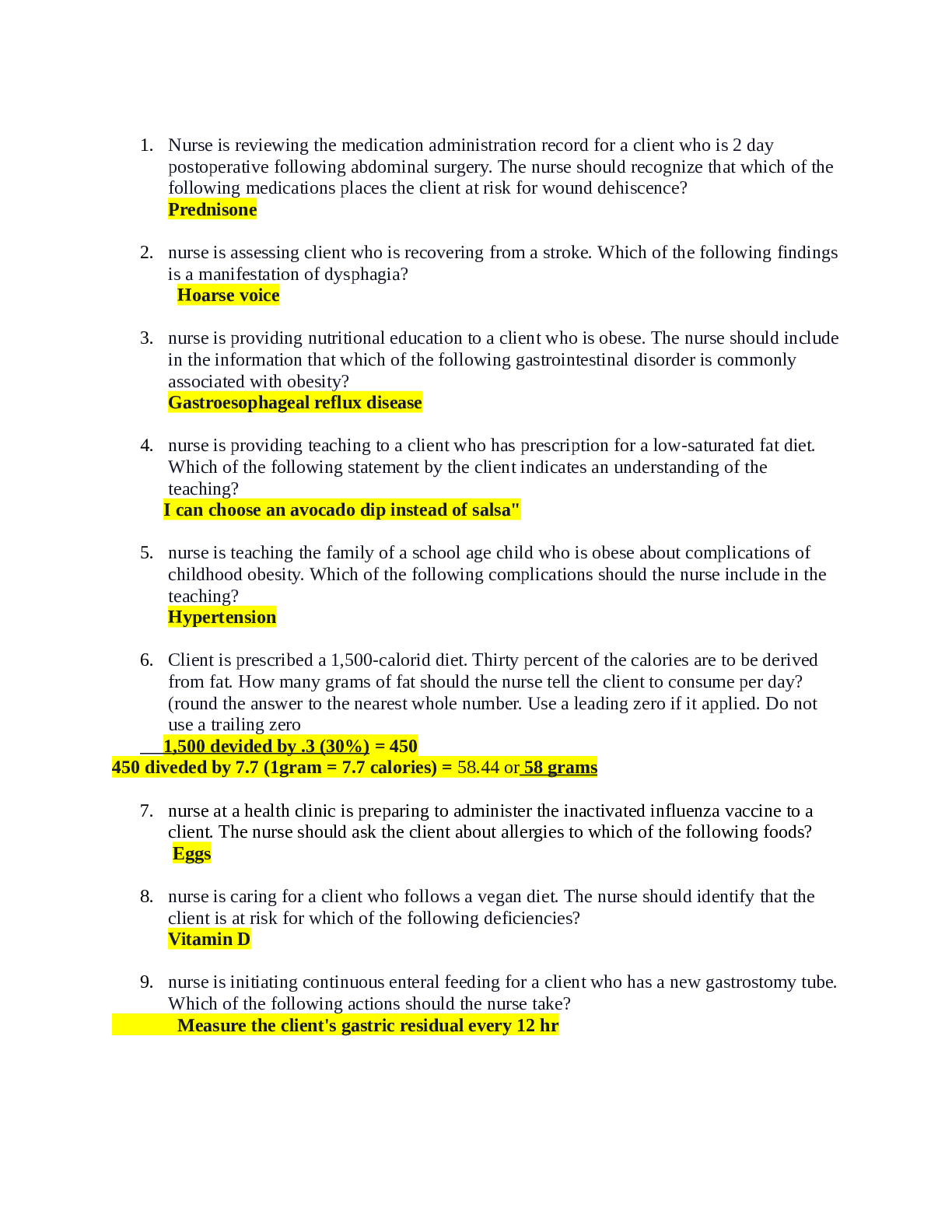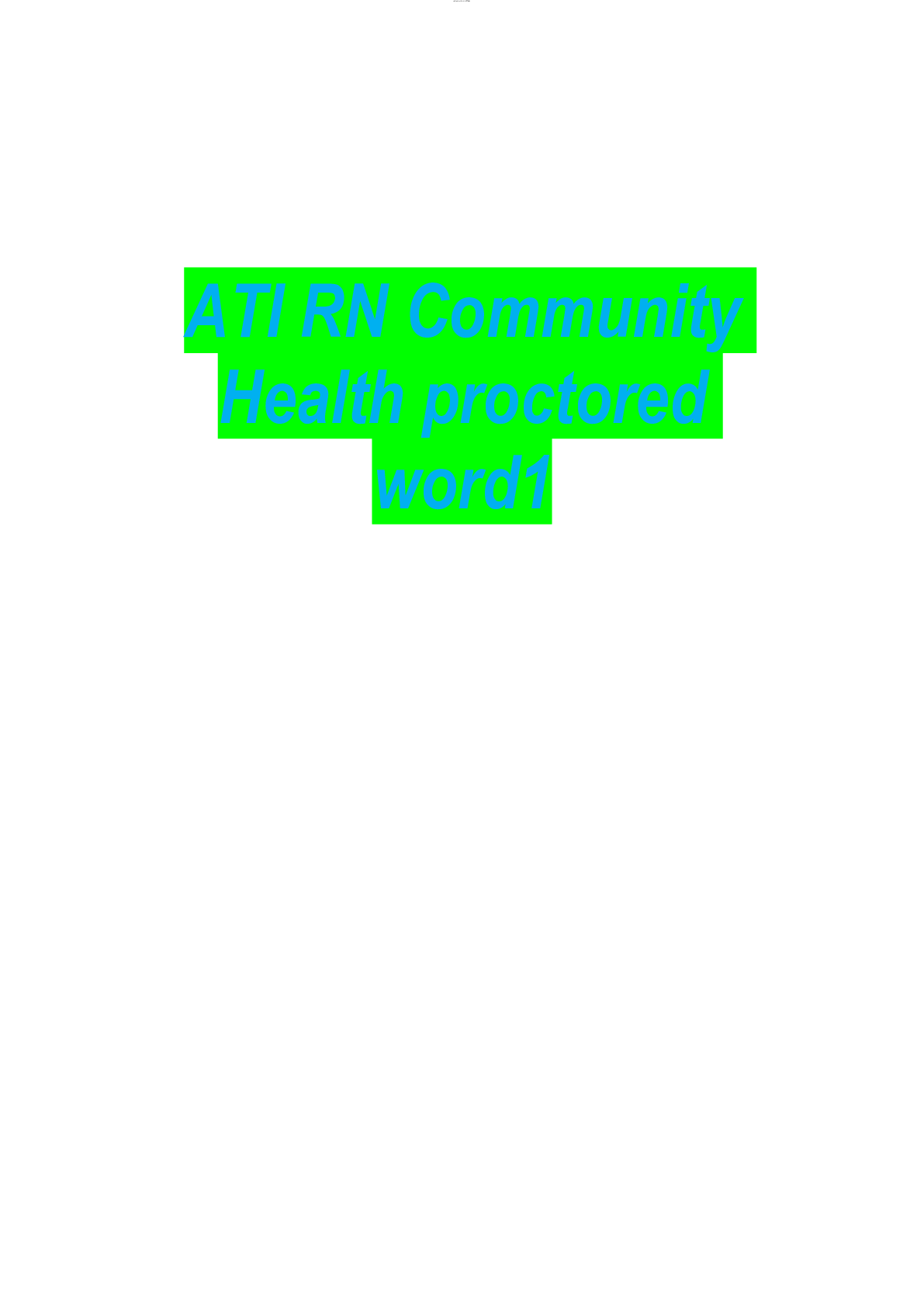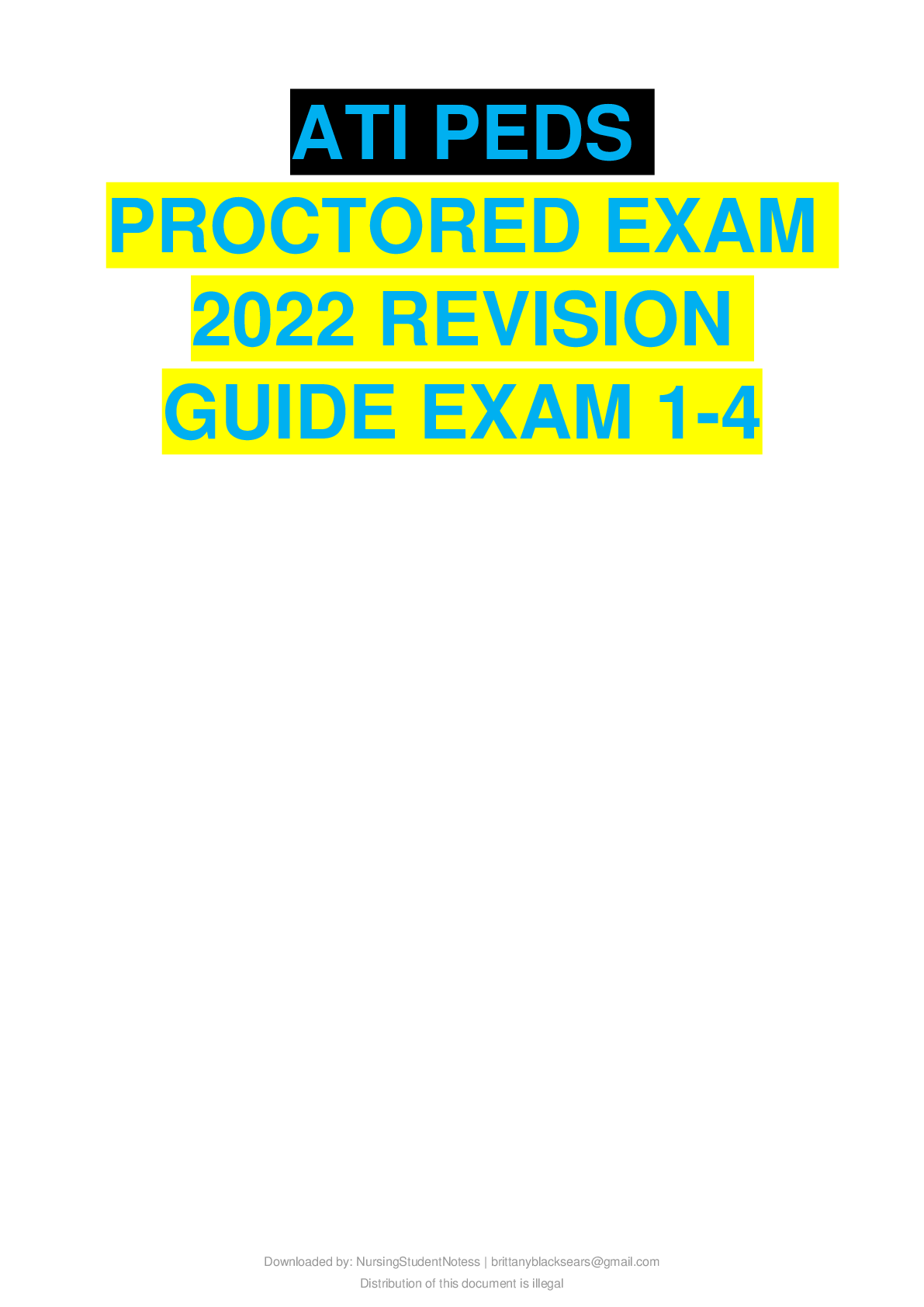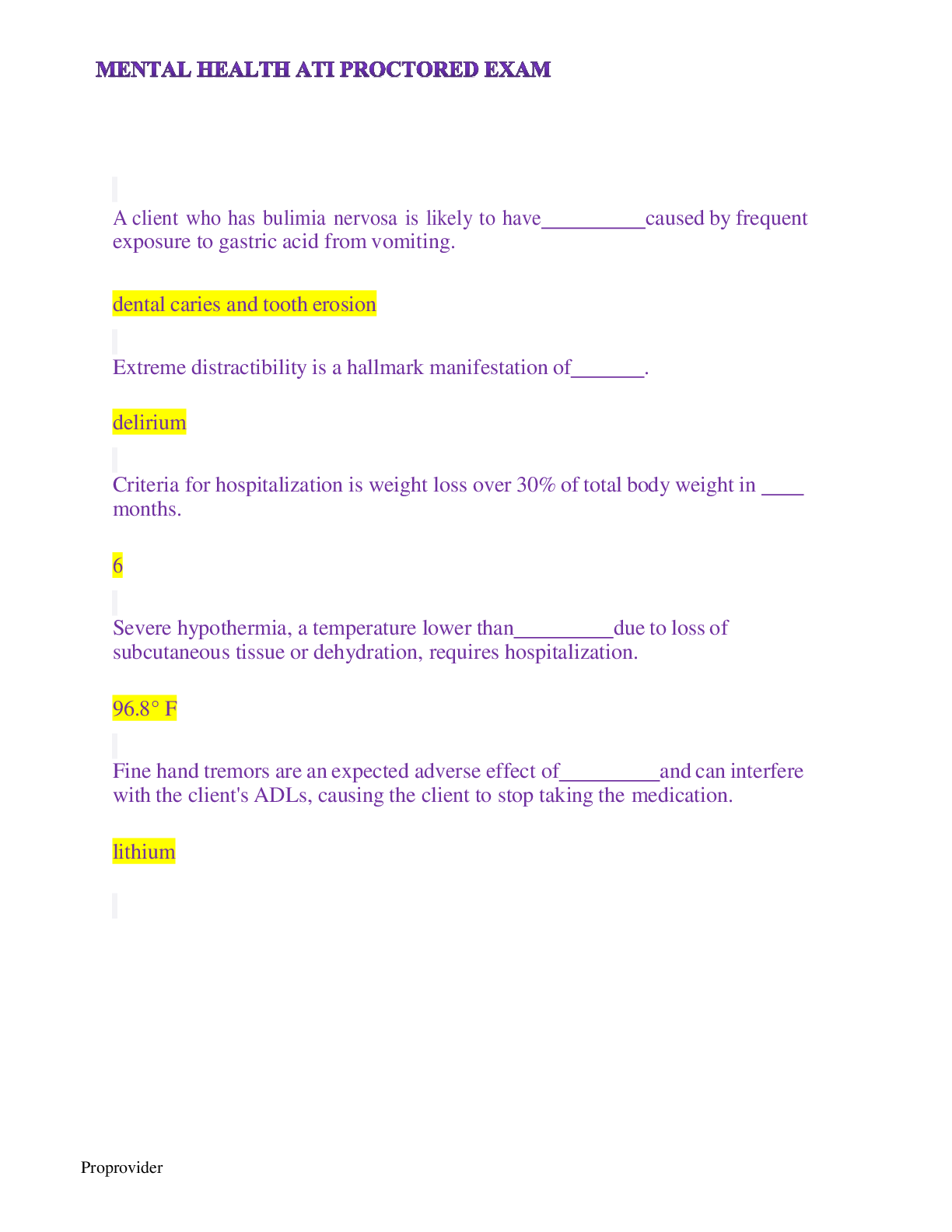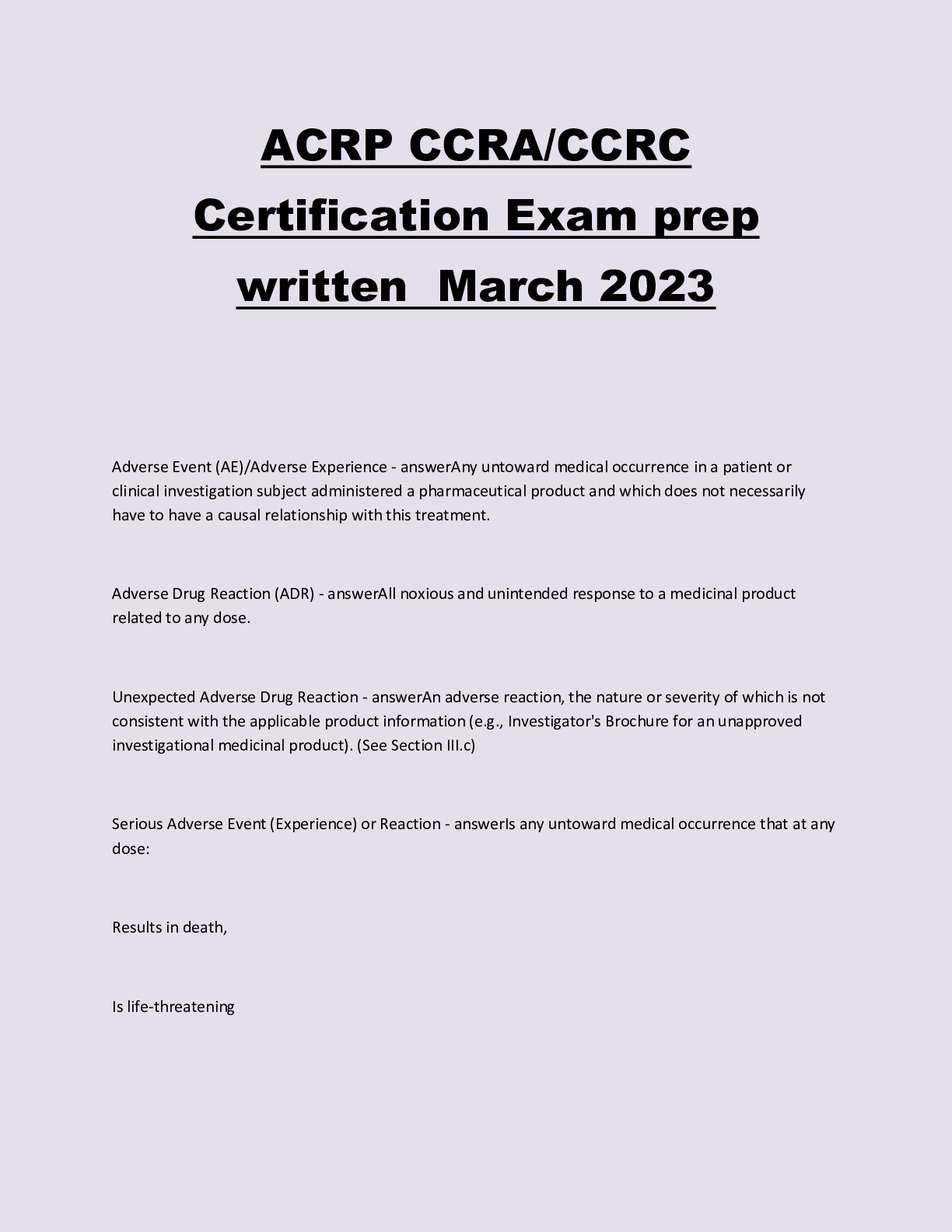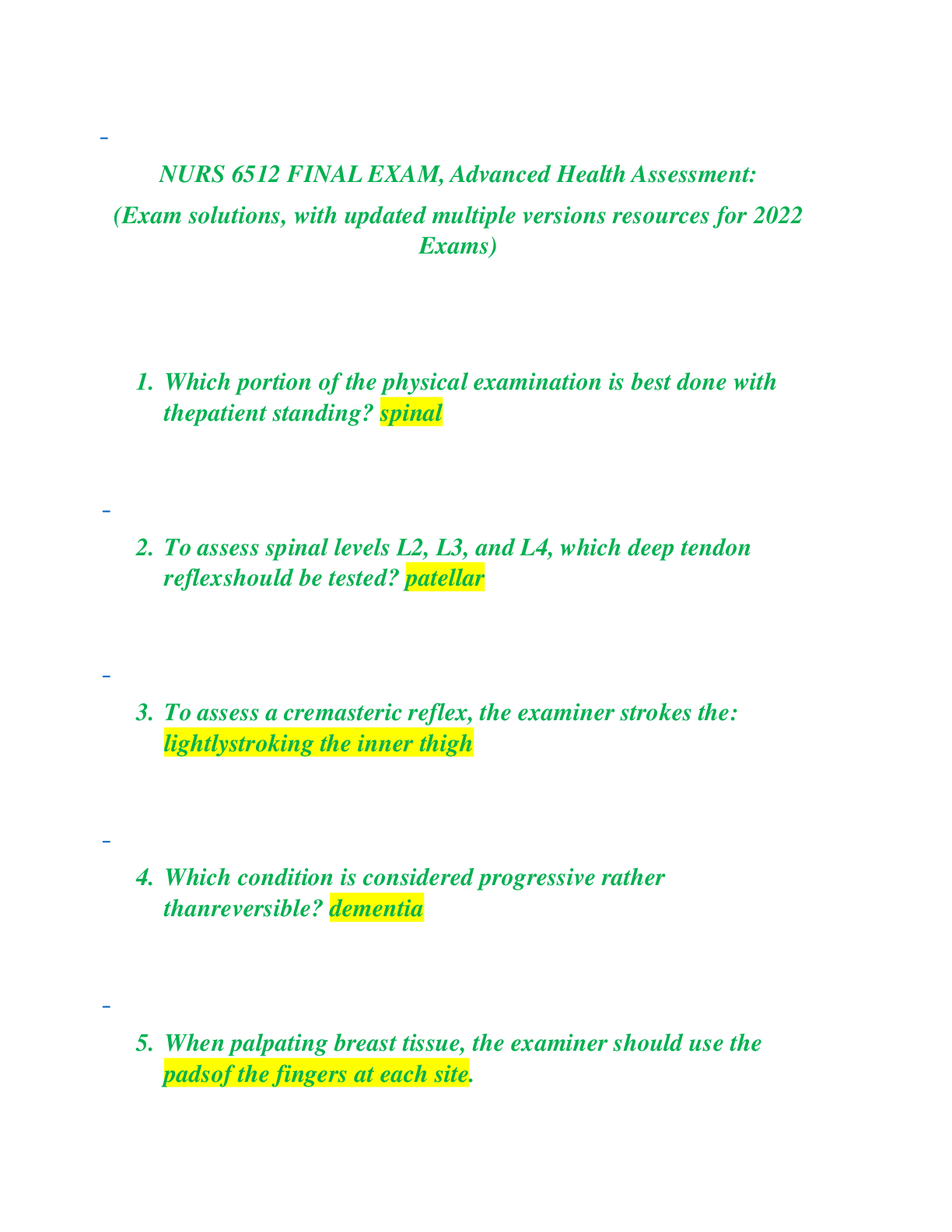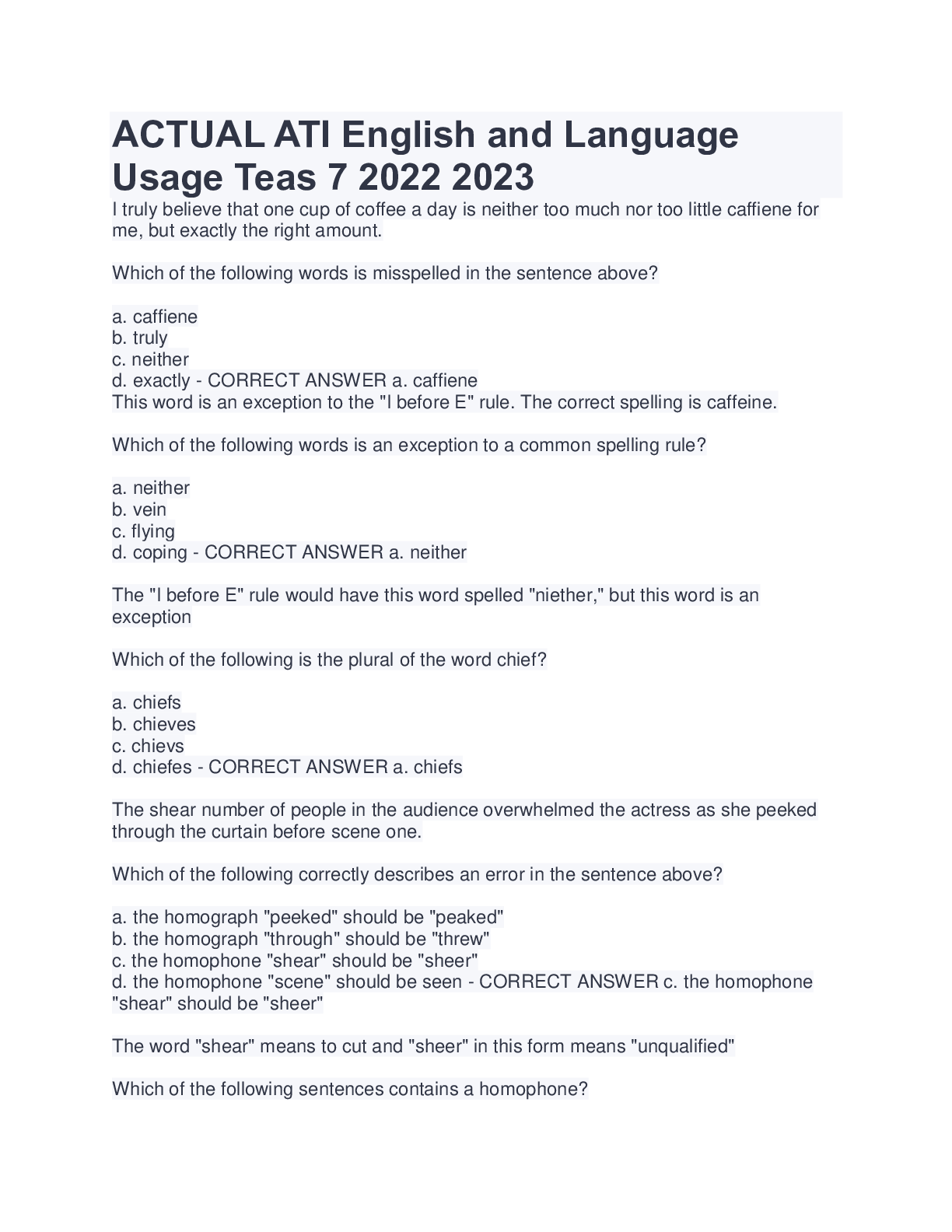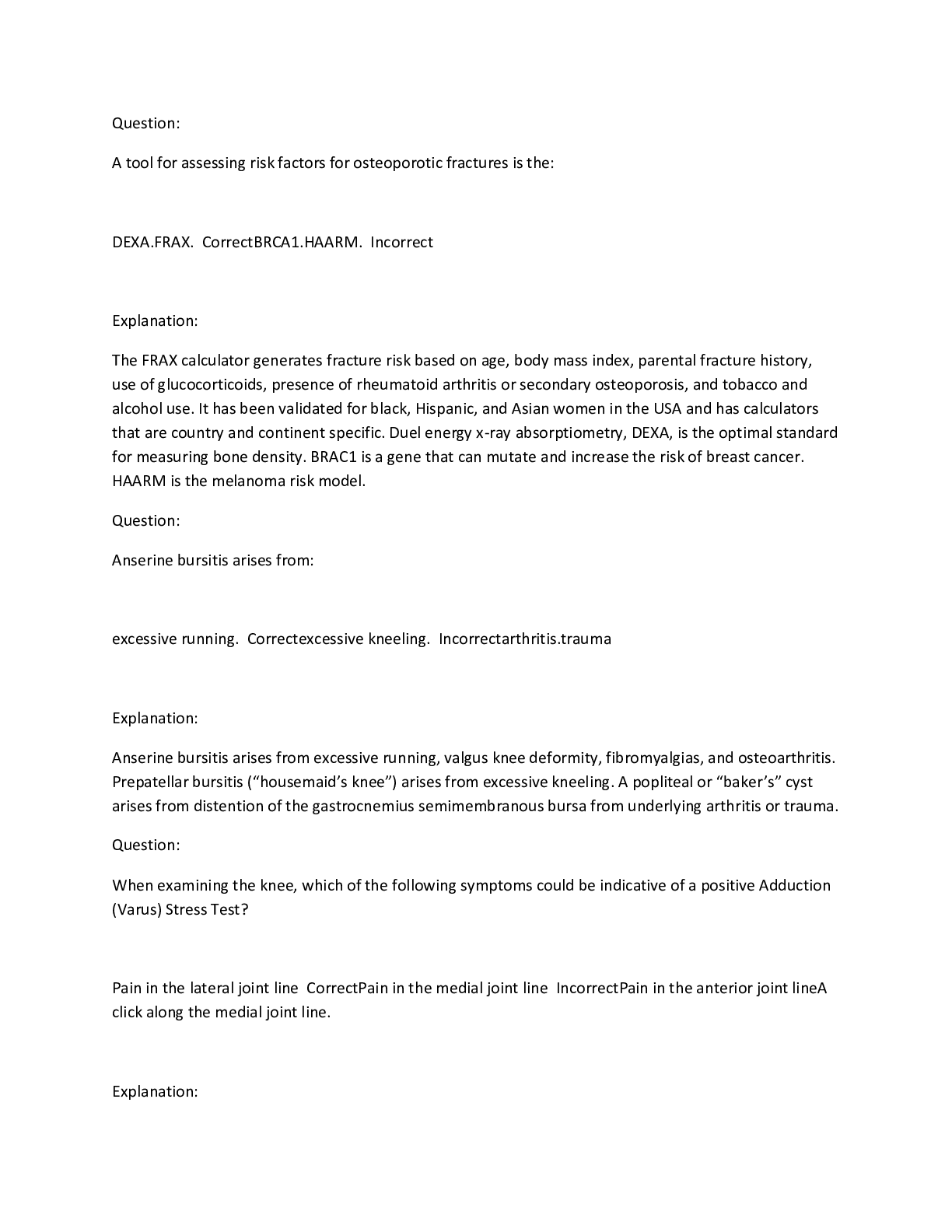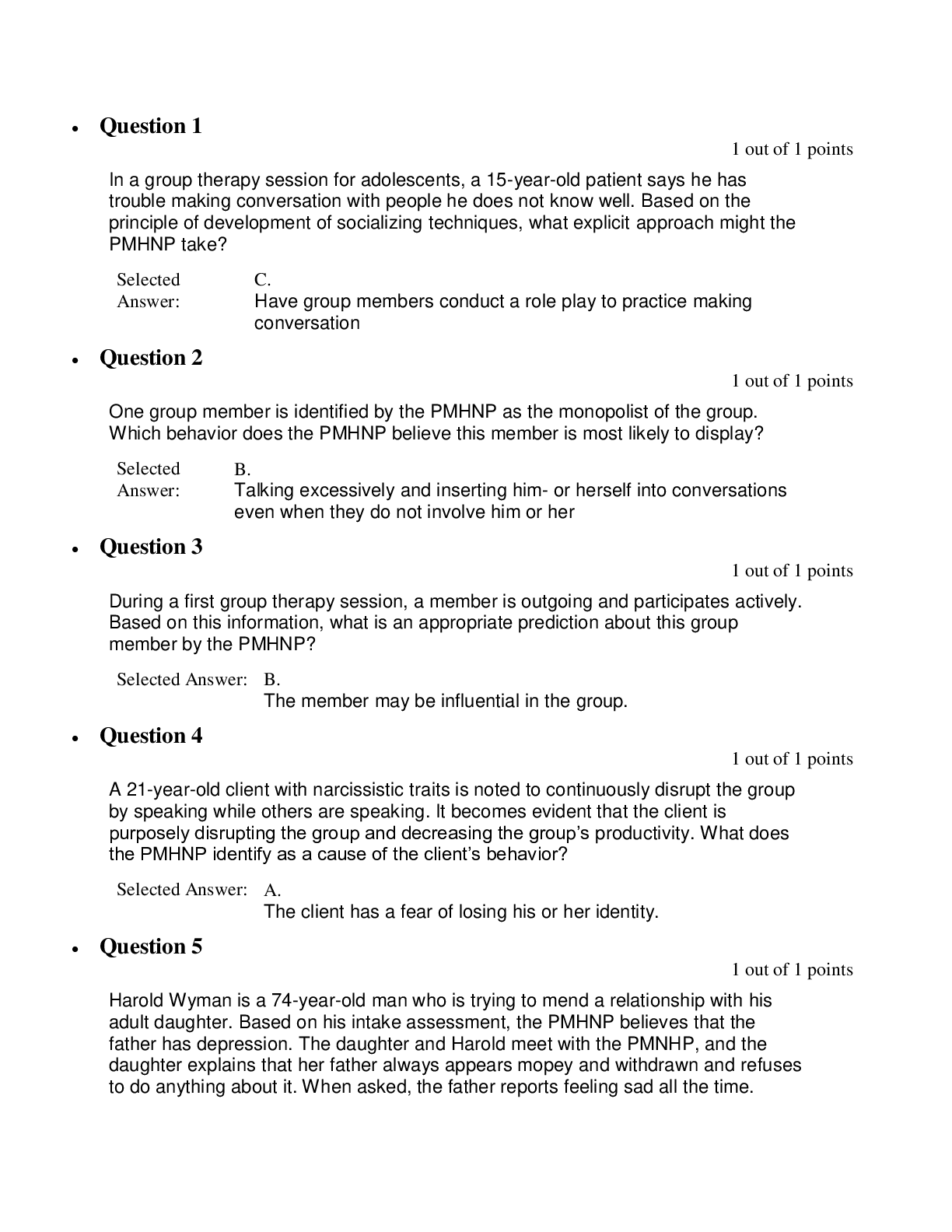Health Care > EXAM > Test Bank Focus On Nursing Pharmacology 8th Edition final Test chapter 1- 59 ( 980) Questions and A (All)
Test Bank Focus On Nursing Pharmacology 8th Edition final Test chapter 1- 59 ( 980) Questions and Answers correctly Answered Quranteed A+(Edition by Karch)
Document Content and Description Below
Test Bank Focus On Nursing Pharmacology 8th Edition final Test chapter 1- 59 ( 980) Questions and Answers correctly Answered Quranteed A+(Edition by Karch) 1 ... Table of Contents Table of Contents 1 Chapter 01 - Introduction to Drugs Chapter 02 - Drugs and the Body Chapter 03 - Toxic Effects of Drugs Chapter 04 - The Nursing Process in Drug Therapy and Patient Safety Chapter 05 - Dosage Calculations Chapter 06 - Challenges to Effective Drug Therapy Chapter 07 - Introduction to Cell Physiology Chapter 08 - Antiinfective Agents Chapter 09 - Antibiotics Chapter 10 - Antiviral Agents Chapter 11 - Antifungal Agents Chapter 12 - Antiprotozoal Agents Chapter 13 - Anthelmintic Agents Chapter 14 - Antineoplastic Agents Chapter 15 - Introduction to the Immune Response and Inflammation Chapter 16 - Antiinflammatory, Antiarthritis, and Related Agents Chapter 17 - Immune Modulators Chapter 18 - Vaccines and Sera Chapter 19 - Introduction to Nerves and the Nervous System Chapter 20 - Anxiolytic and Hypnotic Agents Chapter 21 - Antidepressant Agents Chapter 22 - Psychotherapeutic Agents Chapter 23 - Antiseizure Agents Chapter 24 - Antiparkinsonism Agents Chapter 25 - Muscle Relaxants Chapter 26 - Narcotics, Narcotic Antagonists, and Antimigraine Agents Chapter 27 - General and Local Anesthetic Agents Chapter 28 - Neuromuscular Junction Blocking Agents Chapter 29 - Introduction to the Autonomic Nervous System Chapter 30 - Adrenergic Agonists Chapter 31 - Adrenergic Antagonists Chapter 32 - Cholinergic Agonists Chapter 33 - Anticholinergic Agents Chapter 34 - Introduction to the Endocrine System Chapter 35 - Hypothalamic and Pituitary Agents Chapter 36 - Adrenocortical Agents Chapter 37 - Thyroid and Parathyroid Agents Chapter 38 - Agents to Control Blood Glucose Levels Chapter 39 - Introduction to the Reproductive System Chapter 40 - Drugs Affecting the Female Reproductive System Chapter 41 - Drugs Affecting the Male Reproductive System Chapter 42 - Introduction to the Cardiovascular System Chapter 43 - Drugs Affecting Blood Pressure Chapter 44 - Agents for Treating Heart Failure Chapter 45 - Antiarrhythmic Agents Chapter 46 - Antianginal Agents Chapter 47 - Lipid-Lowering Agents Chapter 48 - Drugs Affecting Blood Coagulation Chapter 49 - Drugs Used to Treat Anemias Chapter 50 - Introduction to the Renal System 3 20 37 54 71 86 103 120 138 155 172 188 204 220 237 254 270 287 304 320 337 354 371 388 404 420 436 453 470 487 503 520 536 553 569 585 602 619 636 653 669 685 702 719 735 752 768 785 801 817 Chapter 51 - Diuretic Agents Chapter 52 - Drugs Affecting the Urinary Tract and the Bladder Chapter 53 - Introduction to the Respiratory System Chapter 54 - Drugs Acting on the Upper Respiratory Tract Chapter 55 - Drugs Acting on the Lower Respiratory Tract Chapter 56 - Introduction to the Gastrointestinal System Chapter 57 - Drugs Affecting Gastrointestinal Secretions Chapter 58 - Drugs Affecting Gastrointestinal Motility Chapter 59 - Antiemetic Agents 833 849 866 883 900 917 933 949 965 Chapter 01 - Introduction to Drugs A nurse working in radiology administers iodine to a patient who is having a computed tomography(CT) scan. The nurse working on the oncology unit administers chemotherapy to patients who have cancer. At the Public Health Department, a nurse administers a measles-mumps-rubella (MMR) vaccine to a 14-month-old child as a routine immunization. Which branch of pharmacology best describes the actions of all three nurses? Pharmacoeconomics Pharmacotherapeutics Pharmacodynamics Pharmacokinetics Ans: B Feedback: Pharmacology is the study of the biologic effects of chemicals. Nurses are involved with clinical pharmacology or pharmacotherapeutics, which is a branch of pharmacology that deals with the uses of drugs to treat, prevent, and diagnose disease. The radiology nurse is administering a drug to help diagnose a disease. The oncology nurse is administering a drug to help treat a disease. Pharmacoeconomics includes any costs involved in drug therapy. Pharmacodynamics involves how a drug affects the body and pharmacokinetics is how the body acts on the body. A physician has ordered intramuscular (IM) injections of morphine, a narcotic, every 4 hours as neededfor pain in a motor vehicle accident victim. The nurse is aware this drug has a high abuse potential. Under what category would morphine be classified? Schedule I Schedule II Schedule III Schedule IV Ans: B Feedback: Narcotics with a high abuse potential are classified as Schedule II drugs because of severe dependence liability. Schedule I drugs have high abuse potential and no accepted medical use. Schedule III drugs have a lesser abuse potential than II and an accepted medical use. Schedule IV drugs have low abuse potential and limited dependence liability. When involved in phase III drug evaluation studies, what responsibilities would the nurse have? Working with animals who are given experimental drugs Choosing appropriate patients to be involved in the drug study Monitoring and observing patients closely for adverse effects Conducting research to determine effectiveness of the drugAns: C Feedback: Phase III studies involve use of a drug in a vast clinical population in which patients are asked to record any symptoms they experience while taking the drugs. Nurses may be responsible for helping collect and analyze the information to be shared with the Food and Drug Administration (FDA) but would not conduct research independently because nurses do not prescribe medications. Use of animals in drug testing is done in the preclinical trials. Select patients who are involved in phase II studies to participate in studies where the participants have the disease the drug is intended to treat. These patients are monitored closely for drug action and adverse effects. Phase I studies involve healthy human volunteers who are usually paid for their participation. Nurses may observe for adverse effects and toxicity. What concept is considered when generic drugs are substituted for brand name drugs? Bioavailability Critical concentration Distribution Half-life Ans: A Feedback: Bioavailability is the portion of a dose of a drug that reaches the systemic circulation and is available to act on body cells. Binders used in a generic drug may not be the same as those used in the brand name drug. Therefore, the way the body breaks down and uses the drug may differ, which may eliminate a generic drug substitution. Critical concentration is the amount of a drug that is needed to cause a therapeutic effect and should not differ between generic and brand name medications. Distribution is the phase of pharmacokinetics, which involves the movement of a drug to the body’s tissues and is the same in generic and brand name drugs. A drug’s half-life is the time it takes for the amount of drug to decrease to half the peak level, which should not change when substituting a generic medication. A nurse is assessing the patient’s home medication use. After listening to the patient list current medications, the nurse asks what priority question? Do you take any generic medications? Are any of these medications orphan drugs? Are these medications safe to take during pregnancy? Do you take any over-the-counter medications? Ans: D Feedback: It is important for the nurse to specifically question use of over-the-counter medications because patients may not consider them important. The patient is unlikely to know the meaning of orphan drugs unless they too are health care providers. Safety during pregnancy, use of a generic medication, or classification of orphan drugs are things the patient would be unable to answer but could be found in reference books if the nurse wishes to research them. After completing a course on pharmacology for nurses, what will the nurse know? Everything necessary for safe and effective medication administration Current pharmacologic therapy; the nurse will not require ongoing education for 5 years. General drug information; the nurse can consult a drug guide for specific drug information. The drug actions that are associated with each classification of medicationAns: C Feedback: After completing a pharmacology course nurses will have general drug information needed for safe and effective medication administration but will need to consult a drug guide for specific drug information before administering any medication. Pharmacology is constantly changing, with new drugs entering the market and new uses for existing drugs identified. Continuing education in pharmacology is essential to safe practice. Nurses tend to become familiar with the medications they administer most often, but there will always be a need to research new drugs and also those the nurse is not familiar with because no nurse knows all medications. A nurse is instructing a pregnant patient concerning the potential risk to her fetus from a Pregnancy Category B drug. What would the nurse inform the patient? Adequate studies in pregnant women have demonstrated there is no risk to the fetus. Animal studies have not demonstrated a risk to the fetus, but there have been no adequate studiesin pregnant women. Animal studies have shown an adverse effect on the fetus, but there are no adequate studies inpregnant women. There is evidence of human fetal risk, but the potential benefits from use of the drug may beacceptable despite potential risks. Ans: B Feedback: Category B indicates that animal studies have not demonstrated a risk to the fetus. However, there have not been adequate studies in pregnant women to demonstrate risk to a fetus during the first trimester of pregnancy and no evidence of risk in later trimesters. Category A indicates that adequate studies in pregnant women have not demonstrated a risk to the fetus in the first trimester or in later trimesters. Category C indicates that animal studies have shown an adverse effect on the fetus, but no adequate studies in humans. Category D reveals evidence of human fetal risk, but the potential benefits from the use of the drugs in pregnant women may outweigh potential risks. Discharge planning for patients leaving the hospital should include instructions on the use of over-the- counter (OTC) drugs. Which comment by the patient would demonstrate a good understanding of OTC drugs? OTC drugs are safe and do not cause adverse effects if taken properly. OTC drugs have been around for years and have not been tested by the Food and Drug Administration (FDA). OTC drugs are different from any drugs available by prescription and cost less. OTC drugs could cause serious harm if not taken according to directions. Ans: D [Show More]
Last updated: 2 years ago
Preview 1 out of 982 pages
Buy this document to get the full access instantly
Instant Download Access after purchase
Buy NowInstant download
We Accept:

Reviews( 0 )
$19.00
Can't find what you want? Try our AI powered Search
Document information
Connected school, study & course
About the document
Uploaded On
Feb 28, 2023
Number of pages
982
Written in
Additional information
This document has been written for:
Uploaded
Feb 28, 2023
Downloads
0
Views
100

